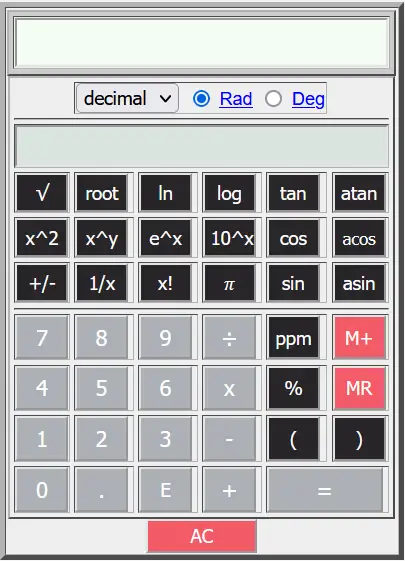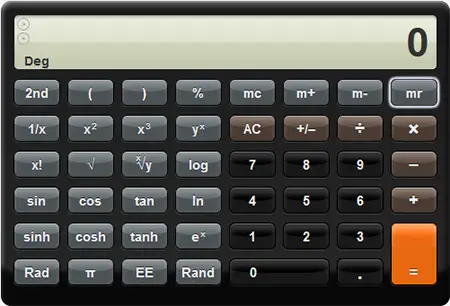
|
Calculator Library |

|
||||||||
| Home » 87 Calculators » Blog » Scientific Calculators | ||||||||||
SCIENTIFIC CALCULATORSScientific calculators are simply advanced calculators designed to help you calculate problems relating to science, engineering and mathematics. Unlike standard calculators, scientific calculators can handle advanced functions in areas such as physics, chemistry, scientific notation, engineering, geometry and trigonometry. These additional scientific functions mean they have many more keys and use more memory than standard calculators. Here at CalculatorLibrary, we have 2 free online scientific calculators:
In recent years, we have seen some significant improvements to scientific calculators, including WiFi and the ability to share work with others, however the main functions are quite universal across all brands and models. Here are some of the main functions for a scientific calculator. Simplicity and speedThere was a time when scientific calculations were done almost completely by hand. Now, it only takes a moment to enter the data and solve the problem using an advanced scientific calculator. Often difficult problems can be solved quickly and easily using just one or two keys. Basic functions and exponentsIn addition to all the advanced scientific functions, scientific calculators can still handle the basic calculator functions such as addition, subtraction, multiplication and division. However, remember that subtraction is a separate function from negation, which often causes confusion because the keys look similar. Exponents, unknown numbersExponents raise numbers to another power. They are used in most higher math courses, but only scientific calculators can handle algebraic functions. In addition to solving for a known number, you can also use these calculators for an unknown number. This is important for algebra and other advanced math problems. Order of operationsStandard calculators work well to solve simple equations with one or two variables, but they can't resolve which numbers should be processed first. On the other hand, scientific calculators allow you to enter problems with an order of operations, using parentheses to solve more complex problems. This tells the calculator which operation to perform first, in the same way you would calculate it manually, on paper. Square rootOne of the simplest operations on a scientific calculator is finding the square root of a number. Simply enter the number and press the √ key to calculate the result. LogarithmsIf you're dealing with calculations related to calculus and trigonometry, it's likely you'll be using logarithms. These formulas are the inverse of exponents and help calculate measurements in a multitude of areas such as growth, speed and area. Logarithms are mostly used in the medical and engineering fields but they have wide application across industry for processes such as computer modeling and statistical analysis. The secret to dealing with logarithms is is often simply knowing how to enter the correct formula on a scientific calculator. To use these functions, make sure your calculator includes log and Ln keys. Memory advantage when using logarithmsAnother advantage when using a scientific calculator for logarithms is that there's an inbuilt memory which can store equations. If you're solving a problem over several sessions, you can store your current input and return later if you take a break or want to try another solution. Sine, cosine and tangent functionsSine, cosine and tangent functions represent the ratios of the sides of a right-angled triangle. These ratios are fundamental to studies of calculus and trigonometry and those working in any type of engineering or architectural field. Calculations commonly involve finding unknown values in an equation. Like logarithms, these calculations were once complicated, however scientific calculators can now give you the answer very quickly after you enter the correct formula. To use these functions, make sure your calculator includes sin, cos and tan keys. Sine functionsThe sine is the ratio of the opposite side of a right-angled triangle to the hypotenuse (the longest side of a right-angled triangle, opposite the right angle). A sine function is used to measure angles, especially when sides or angles are unknown. The inverse sine is particularly useful to calculate the hypotenuse of a triangle. Cosine functionsThe cosine is the ratio of the adjacent side of a right-angled triangle to the hypotenuse and is most commonly used to find the length of a triangle's hypotenuse. Scientific calculators can also calculate in the reverse with inverse cosines. Cosines can be found for any angle, even if they are large or negative. Tangents in degrees or radiansThe tangent is the ratio of the opposite side of a right-angled triangle to the adjacent side. Tangents are fundamental in trigonometry and are often used to calculate the value of the side opposite known values. The result can be calculated in either degrees or radians. In geometry, tangents are useful when calculating perpendicular lines. Important Note: Check your calculator is correctly set to degrees or radians to ensure you get the result you want. GraphingWhen working with these calculations, it's often necessary to graph and solve sine and cosine functions. This is a clear and visual way to present results and many courses require a knowledge of graphing these various functions. Scientific notationIn addition to solving complicated math problems, scientific calculators have a big advantage by using scientific notation. When numbers are too large to be expressed in decimal point form, a standard calculator won't work. They can only calculate with smaller values, so you'll need a scientific calculator to deal with numbers on a huge scale. They can also deal with negative scientific notation. Scientific notation is commonly used in fields related to science, engineering and mathematics, particulaly when collecting data or working in the physics or chemistry fields. It may be helpful to note here that many scientific calculators have a special mode that can help when calculating engineering equations. Check to see if your calculator has an "ENG" display mode, designed to help communicate numbers verbally by reading. To see an example of scientific notation, click here to open our Scientific Calculator then follow these 2 simple steps:
Binary functionsIn the same way you would use equations to calculate logs or notations, sines or tangents, a scientific calculator can calculate binary functions, which require two inputs. These equations can be difficult to keep track of unless you have a calculator with memory, because this allows you to store the results of each step, build multiple steps over time, then save your progress for later. Binary functions are common in algebra and calculus when solving for an unknown value, but also appear when working with the Cartesian product and its subsets.
|
|
|||||||||
Copyright © Calculator Library, 1998 - 2025. Made with ♥ in Australia. |
||||||||||

